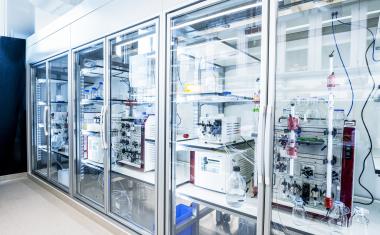25 Years of Pioneering Video Security




Now more than a quarter of a century has passed since Dallmeier was founded in 1984. In the meantime, the Regensburg based company has built up an international reputation and is known as a leading provider of network-based video surveillance systems.
The company has come a long way and we spoke with its founder, Dieter Dallmeier, who recalled the story of the past twenty-five years for us.
GIT SECURITY: Mr. Dallmeier, how did it all begin and how did you manage to establish the company internationally?
D. Dallmeier: In 1984 I decided to go into business for myself as a master television technician. For many years, the company rested upon two people, my wife Christina and me. It took some time and wasn‘t always easy to come to where we are now with around 300 employees. There have repeatedly been hard times, some lasted longer than others and some passed by quicker.
That is why today, I am particularly proud that we have remained persistent through all those years and always believed in our visions and ideas. Eventually, Dallmeier was able to decisively influence the market. The development of the world‘s first digital video sensor with digital picture memory, which was introduced to experts in 1992, represents a milestone in the evolution of the industry and also in digital technology for security equipment.
In 1997 we made our breakthrough with the development of the first digital solution for gaming tables for the Crown Casino in Australia. The rising demand for Dallmeier products allowed us to stabilize the business and to achieve constant growth up to this day.
It has truly been a long way. What motivated you to keep working hard through all those years?
D. Dallmeier: I was mainly driven by passion and enthusiasm for developing as well as advancing forward-looking technologies. In doing so, I have never shied away from pursuing unconventional approaches. It has been very rewarding to produce pioneer work in video security technology over all those years. It is still incredibly exciting to repeatedly give new impetus to the market and to see the direct effects that it can have on an entire industry.
That passion for our work has also become an integral part of our corporate philosophy and is also shared by the entire workforce. That is why we manage to break new moulds, again and again, with undeviating faith in what we do, and why we are always able to be a step ahead. I am particularly happy that our employees share my passion and that every one of them puts their hearts and souls into their work.
You have always been able to bank on the right trends. How did you do that?
D. Dallmeier: It has shown that long-term planning and an uncompromising focus on quality always pay off in the long run. Trends, whether in the stock market or in technical areas, are very often short-lived. Only a few technological hypes have been able to establish themselves. While others were still trying to proclaim the unique, a follow-up technology had caught up with them or even overtaken them.
Often it isn‘t easy to recognize technological change early on and incorporate it into one‘s own development plans at the right time. In this regard we have always been guided by one thought: how can the customer benefit from this technology? By systematically concentrating our development on functionality and ease of use, we managed to create reliable and practically-oriented solutions for professional video security on every occasion.
How do you feel about issues like environmental protection and social responsibility?
D. Dallmeier: From the very beginning, Dallmeier has not only felt committed to economic success. For me as the founder and head of the company, it is equally important that we recognize our social responsibility. This conviction shapes all our corporate activities. In the past, Dallmeier has been pioneering in video security technology in many ways and will continue to develop innovative products which set the benchmark for the industry. With the same energy that the company uses to promote its economic success, it also devotes itself to taking up social responsibility.
Various aspects of our corporate culture prove that this is not just lip service. The working atmosphere at Dallmeier is characterized by mutual respect, open-mindedness and interest for the work of colleagues. Introducing ones own ideas and helping each other are equally prominent aspects of that atmosphere. Dallmeier aims at representing the idea of being there for each other to the outside world as well and thus supports a number of aid groups around the world. When it comes to environmental protection Dallmeier is amongst those companies that not only strictly adhere to existing laws. Rather we voluntarily impose even more demanding requirements on our corporate activity wherever it seems prudent and possible.
Dallmeier pursues economic success, of course, and asks to be measured by the satisfaction of its customers. However, in doing so, we do not allow benevolence to fall by the wayside.
How will the future look for Dallmeier?
D. Dallmeier: Of course, I can‘t predict what the coming years will bring. But I am looking forward to continue working on our vision and face future challenges and to do so together with my wife Christina, my son Thomas, who is already active in the firm and shares my passion, and with all our employees.
We have many ideas and always push the development of trendsetting solutions for video security. In doing so, the requirements of our customers still come first.
most read

Relocation of Chemicals Production Footprint in Full Swing
A new Horváth study based on interviews with CxOs of Europe’s top chemical corporations reveals: The majority of board members expects no or only weak growth for the current year.

ECA Foundation Aims to Become Largest Pharma Association for GMP/GDP Compliance
The ECA Foundation, one of the most important not-for-profit organizations for regulatory expertise in the pharmaceutical industry, aims to become the largest independent GMP/GDP organization in the world.

ISPE Good Practice Guide: Validation 4.0
The Validation 4.0 Guide provides a comprehensive approach to ensuring product quality and patient safety throughout a pharmaceutical product's lifecycle.

20 Years of CHEManager International
Incredible but true: CHEManager International is celebrating its 20th anniversary!

US Tariffs Fatal for European Pharma
Trump's tariff policy is a considerable burden and a break with previous practice.












